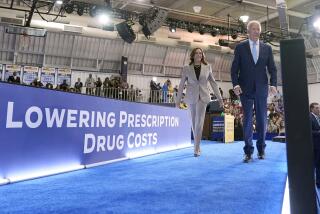Elderly Paying Double for Prescriptions
- Share via
WASHINGTON — Prescription drug prices paid individually by millions of elderly Americans without insurance are at least twice as high as those paid by managed care plans and the federal government, according to a new congressional study released Friday.
The survey, which examined the prices of the top 10 drugs used by elderly patients, was undertaken by a group of House Democrats who had received complaints from the elderly in their districts.
The study found that the prices were on average 106% higher for elderly patients than for large buyers. In Los Angeles, the drugs’ prices for elderly patients were 127% higher.
Medicare, the government-subsidized health insurance for the elderly, covers only hospital and doctor visits. Elderly Americans who want insurance for prescription drugs have to buy a separate policy. At least 15 million Americans over age 65 lack such coverage, according to statistics from the Health Care Financing Administration and the American Assn. of Retired Persons.
“We promised elderly people that Medicare would be there to keep them from being wiped out by the high cost of health care, but now the high price of drugs is driving them into poverty lifestyles,” said Rep. Henry A. Waxman (D-Los Angeles).
The Democrats announced that they were introducing a bill designed to control drug prices for the elderly. The legislation, sure to be controversial, would allow all Medicare beneficiaries to use a prescription card entitling them to pay reduced drug prices similar to those paid by other large buyers. The Democrats said their plan would cost taxpayers nothing.
Pharmaceutical company representatives immediately blasted the proposed legislation as thinly disguised price regulation, which is an anathema to business. Insurers said the remedy was problematic but agreed that high drug prices are a problem for at least some elderly.
Although the elderly account for just 12% of the U.S. population, they use 35% of all prescription drugs. And while the high drug prices are the same as those paid by younger people who lack insurance coverage for prescription drugs, the burden falls more heavily on older Americans because they typically live on fixed incomes and use more medications than their younger counterparts, according to Waxman and others.
And when elderly patients cannot afford a doctor-prescribed drug, they often do not fill the prescription or else take less than the prescribed dosage--reducing or in some cases nullifying the drug’s effect, according to groups that represent the elderly. In some cases, elderly patients report that they are forced to choose between buying drugs or food.
Drug pricing is an extremely complex area in part because drug companies are given a monopoly on the manufacture of new drugs for several years after they first come to market. During that period, the companies try to make back their investment in the research as well as make a profit, resulting in new and often extremely effective drugs that are also very expensive. Once other companies are allowed to make the drugs (so-called generics), the price comes down, but often by then, there is a new, better and more expensive drug available.
Insurance for drugs is available to the elderly through some Medi-Gap policies, which pick up where regular Medicare insurance leaves off, covering deductibles and other costs. Prescription drug coverage also is available through some managed care plans for senior citizens. Not all managed care plans offer prescription drug coverage, however, and some plans put dollar caps on the amount that a patient can use.
The Democratic bill designed to control drug prices was immediately lambasted by the pharmaceutical industry.
Among the drug prices surveyed were those for Ticlid, a stroke drug; the cholesterol-reducing drug Zocor; Norvase, prescribed for high blood pressure; and Zoloft, an antidepressant.
More to Read
Get the L.A. Times Politics newsletter
Deeply reported insights into legislation, politics and policy from Sacramento, Washington and beyond. In your inbox twice per week.
You may occasionally receive promotional content from the Los Angeles Times.










